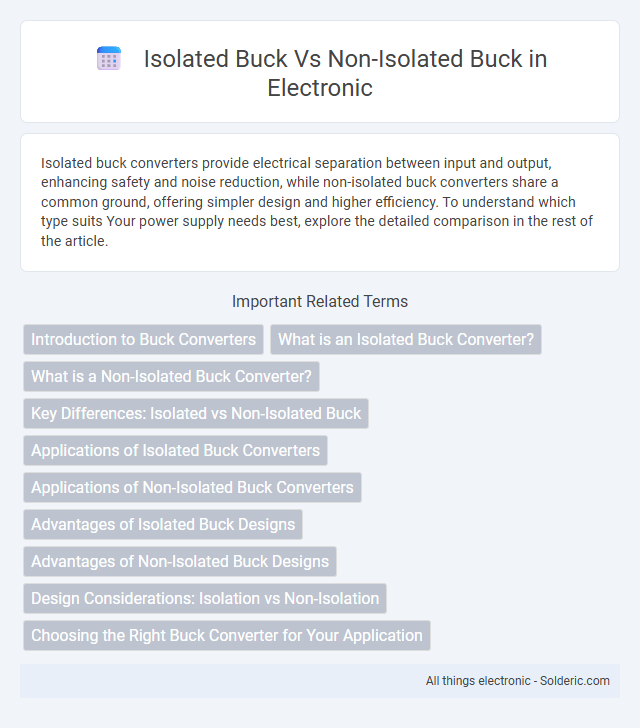Isolated buck converters provide electrical separation between input and output, enhancing safety and noise reduction, while non-isolated buck converters share a common ground, offering simpler design and higher efficiency. To understand which type suits Your power supply needs best, explore the detailed comparison in the rest of the article.
Comparison Table
| Feature | Isolated Buck Converter | Non-Isolated Buck Converter |
|---|---|---|
| Isolation | Provides galvanic isolation using a transformer | No galvanic isolation; direct connection between input and output |
| Safety | Higher safety due to isolation; reduces shock risk | Lower safety; potential shock hazard if not designed properly |
| Complexity | More complex circuitry with transformer and optocoupler | Simpler design, fewer components |
| Cost | Higher cost due to additional components | Lower cost, economical solution |
| Efficiency | Typically slightly lower due to transformer losses | Higher efficiency with fewer conversion losses |
| Applications | Medical devices, industrial equipment, where isolation is mandatory | Consumer electronics, low-risk power supplies |
| Output Voltage Range | Can step up or down voltage via transformer ratios | Only steps down voltage |
| EMI Performance | Better EMI suppression due to isolated design | Higher EMI susceptibility |
Introduction to Buck Converters
Buck converters are essential DC-DC power converters that step down voltage efficiently. Isolated buck converters use galvanic isolation through transformers, enhancing safety and noise reduction, while non-isolated buck converters lack this separation, resulting in simpler and more compact designs. Your choice depends on application requirements like safety standards, size constraints, and electrical noise considerations.
What is an Isolated Buck Converter?
An isolated buck converter uses a transformer to provide electrical isolation between its input and output, enhancing safety and noise reduction in power applications. This isolation prevents direct electrical connection, making it suitable for sensitive electronics and systems requiring ground separation. Unlike non-isolated buck converters, isolated versions can step down voltage while protecting circuits from potential faults and interference.
What is a Non-Isolated Buck Converter?
A Non-Isolated Buck Converter directly connects the input and output grounds, enabling efficient step-down voltage regulation with a simpler design and fewer components. This topology is widely used in applications where input and output share a common ground, providing fast response and high efficiency. Your choice of a non-isolated buck converter suits scenarios requiring cost-effective power management without galvanic isolation.
Key Differences: Isolated vs Non-Isolated Buck
Isolated buck converters provide galvanic isolation between input and output using transformers, enhancing safety and noise immunity, whereas non-isolated buck converters share a common ground, simplifying design and improving efficiency but offering lower isolation. In isolated bucks, the transformer enables voltage step-up or step-down with electrical separation, while non-isolated bucks only step down voltage directly without isolation. Key differences center on electrical isolation, complexity, cost, and application suitability, with isolated bucks suited for sensitive or high-voltage environments and non-isolated bucks favored for compact, low-noise applications.
Applications of Isolated Buck Converters
Isolated buck converters are essential in applications requiring galvanic isolation for safety and noise reduction, such as medical devices, industrial automation, and telecommunications equipment. They provide voltage step-down with electrical isolation between input and output, ensuring protection against high voltage transients and ground loops. These converters are preferred in scenarios demanding compliance with stringent safety standards and electromagnetic interference (EMI) mitigation.
Applications of Non-Isolated Buck Converters
Non-isolated buck converters are widely used in applications requiring efficient step-down voltage regulation with direct electrical connection between input and output grounds. Typical uses include power supplies for microcontrollers, battery-powered devices, and point-of-load modules in computer systems where size and cost efficiency are critical. Your design benefits from their simplicity and higher efficiency in low to medium power applications without the need for galvanic isolation.
Advantages of Isolated Buck Designs
Isolated buck designs offer enhanced safety and noise immunity by providing galvanic isolation between input and output, which is crucial in medical, industrial, and high-voltage applications. Your systems benefit from reduced electromagnetic interference (EMI) and improved protection against ground loops, ensuring reliable and stable power conversion. These features contribute to safer operation and greater design flexibility compared to non-isolated buck converters.
Advantages of Non-Isolated Buck Designs
Non-isolated buck converters offer advantages such as higher efficiency due to fewer components and reduced energy loss in the power transfer process. Their simpler design leads to lower cost and smaller size, making them ideal for applications requiring compact and cost-effective voltage regulation. Non-isolated buck designs also provide faster transient response and ease of implementation in low-voltage, high-current environments.
Design Considerations: Isolation vs Non-Isolation
Isolated buck converters provide galvanic isolation through transformers, enhancing safety and noise immunity, which is crucial for sensitive or high-voltage applications. Non-isolated buck converters offer simpler designs, higher efficiency, and reduced cost by directly connecting input and output grounds, ideal for low-voltage or cost-sensitive systems. Your choice depends on whether isolation is a critical requirement for safety and EMI reduction or if efficiency and design simplicity are more important.
Choosing the Right Buck Converter for Your Application
Isolated buck converters provide galvanic isolation, enhancing safety and reducing electrical noise, making them suitable for sensitive applications like medical devices or industrial equipment. Non-isolated buck converters are more efficient, smaller, and cost-effective, ideal for simpler designs requiring direct voltage step-down without isolation. Your choice depends on the need for isolation, efficiency, size constraints, and application-specific safety requirements.
Isolated Buck vs Non-Isolated Buck Infographic

 solderic.com
solderic.com